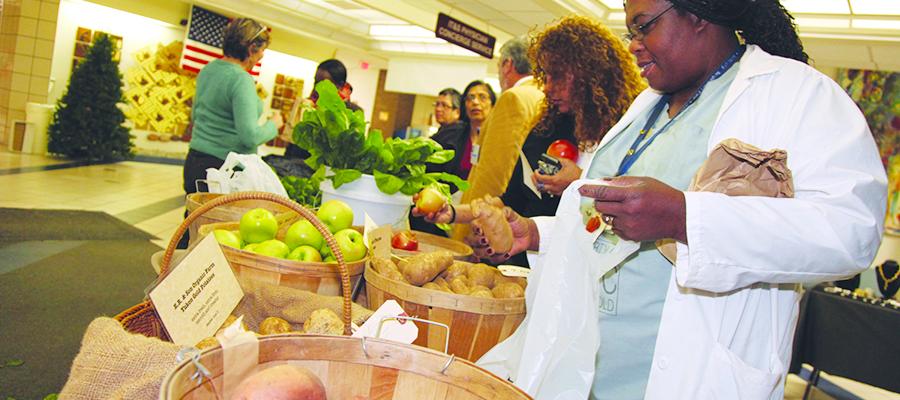Newark Beth Israel Medical Center greenhouse plants seeds for community's health and wellness

Newark (N.J.) Beth Israel Medical Center’s “Beth Greenhouse” is planting the seeds for better health in some of the city’s most food-insecure neighborhoods.
The hospital created an urban garden, farmer’s market and a three-acre hydroponic greenhouse that opened last year as part of its community wellness outreach.
Beth Greenhouse distributes about 100 pounds of food a week – fresh produce like kale, zucchini, tomatoes and peppers. Most of the produce goes to residents living in its urban “food deserts.” Those are neighborhoods without supermarkets carrying a wide variety of fresh produce and other healthy food, but usually plenty of unhealthy fast food joints to choose from.
Beth Greenhouse helps address the grocery gap.
“What’s important to us is not sitting back waiting for people to get sick and come into our emergency department,” says hospital CEO Darrell Terry. “We are concerned about prevention, wellness and creating a healthier Newark.”
The greenhouse is located next door to the hospital. In a unique format, the hospital sells the produce grown at its greenhouse once a week in its farmer’s market – located in the outpatient lobby – to employees, patients and their families and community members who participate in greenhouse activities.
Greenhouse staff host educational programs that teach gardening, nutrition and overall wellness to kids, parents and residents of Newark’s South Ward, where food insecurity is a community concern. More than 3,200 people have participated in greenhouse activities this year.
”You can’t teach people how to eat if you don’t have the food to provide to them,” says Barbara Mintz, the hospital’s senior vice president for healthy living and community engagement. “This is about addressing the social determinants of health that make a real difference in people’s lives.”
Greenhouse participants learn about hands-on farming, nutrition analysis, and preparing healthy and tasty recipes from people like Lorraine Gibbons, the greenhouse’s coordinator and principal farmer. “A farmer in Newark,” she says. “Think about that. But that is part of this hospital’s commitment to its community and to building its credibility with the community.”
Encouraging healthier eating is part of the hospital’s “Beth Embrace Wellness” initiatives. They include “KidsFit,” which addresses the treatment and prevention of childhood obesity through a school-based curriculum that has reached more than 4,000 youngsters. The hospital’s garden complements KidsFit by offering a learning lab about growing and eating healthy food for kids enrolled in the program.
“Beth Challenges” is a successful community-based weight loss and fitness program that has seen participants lose more than 24,000 pounds, and reduce their blood pressure and cholesterol levels by at least 70%.
Also, Beth Israel in October became New Jersey’s first hospital to accept Supplemental Nutrition Assistance Program – or SNAP – benefits as payment for food grown and sold at the greenhouse. The move responds to the more than 114,000 county residents receiving SNAP benefits, including 5,000 in Newark’s South Ward neighborhoods.
It’s a way to get healthy food options to more needy residents, says hospital CEO Terry. “You need the right currency to create more access to healthy foods,” he says. “Now, everyone can participate. No one is being left out.”
Hospital farmer Gibbons says the Beth Greenhouse serves as center of community engagement for a culturally and ethnically diverse population that includes African-Americans, Puerto Ricans, Dominicans, Jamaicans, Haitians and Brazilians, among others.
“We cook together and eat together and learn together,” she says.
Others, like Elizabeth Connelly, the acting commissioner of the state's human services department, commend the hospital's "holistic" approach to population management.
"In urban areas, there often aren't the opportunities or affordable options for fresh produce and that impacts so many health and social factors," she says. "Newark Beth Israel is really at the forefront of community-based holistic wellness initiatives."
Terry says hospitals and health systems "need to be at the table" with other stkeholders to develop sustainable, community-based solutions for better health. "So much of what contributes to a person's health is going on out there in the community," he says. "We need to get to a very granular level if we are going to make a difference. You won't do it by sitting back and preaching."
As health care delivery moves toward a population health paradigm that incentivizes keeping people healthy, hospital community engagement vice president Mintz says hospitals need to recognize and address the social determinants of health, like food insecurity, that can account for 40% or more of a person's health status.
"We want our community to know us not just as a place where people go when they get sick, but also as a wellness center ... a place where people go to stay well and to improve the quality of their lives," she says.

